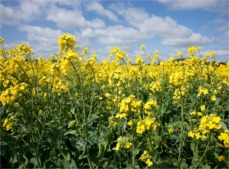Oilseed Rape

A relative newcomer to UK agriculture, OSR, a brassica, has gone from almost unheard of in the 1970s to the fourth largest crop today, as can be witnessed by the sea of yellow in the spring countryside these days.
The oil was originally used for making soap and lamp oil and was toxic to people and livestock because it contained a great deal of erucid acid. In Canada, a more benign variety was developed and given the name Canola - derived from CANadian Oilseed - Low Acid and this is the type grown for human consumption. The original varieties are grown for industrial applications and for biodiesel.
Although far less, Canola types still contain some 2% erucic acid and some other questionable constituents, so there are disputes to this day as to its suitability as a food. It is used in the processed food industry and as a less expensive alternative to olive oil.
OSR is a difficult crop to grow consistently, it is nitrogen-hungry and the yields are not high, averaging 3t/ha and rarely exceeding 3.5 tonnes. This is offset by the returns, which are good. Other major plus points are the eminent suitability of OSR as an effective break crop in a cereal rotation and the fact that there is always a ready market for it.
We do not subscribe to the growing of OSR in the UK for biofuel production for two reasons. We are so far short of being self-sufficient in food production that it makes no sense in the wider scheme of things to deteriorate the position further and it also makes no sense to use large quantities of fossil-derived fuels, agrochemicals and fertiliser to grow an alternative to...fossil fuel! If OSR was a no-input coloniser of marginal land, such as bracken, there would be logic in it.
Despite the negatives, the popularity of oilseed rape grows year on year and the situation is unlikely to change in the near future.
The Dressing Process
Field Science tailored mineral dressings are always based on detailed soil analysis of the field to be treated. A member of our technical team will visit your farm to discuss and identify where we can help. Soil samples are then taken and the tailored dressings are based on the independent laboratory’s results.
The dressings are available in two concentrations:
1 Year Dressing is cheaper per acre and is essential if the soil is ploughed after harvest or if the soil is extremely sandy.
Full Dressing is formulated to last for 2 - 3 seasons from application (subject to nutrient retention qualities of the field). This dressing is cheaper in the long run given the longevity and the cost of application only once every 2 - 3 years but the soil must not be ploughed during this time. Min-tillage is perfectly acceptable.
The best time for application is just after emergence in the case of spring rape and February/March for winter sown rape. This avoids any particularly wet weather.
The application rate is usually 25kg per hectare (10kg/ac) and the most effective method of application is to use an electric spinner (slug-pelleter) on a quad bike. The dressings are packed in 25kg bags, clearly labelled with the farm details, field name, application rate and bag weight.
